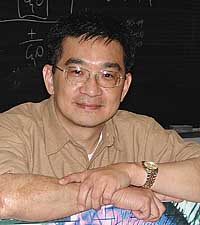Researchers measure importance of natural selection at genetic level
By John EastonMedical Center Public Affairs
 Chung-I Wu |
Researchers from the University have demonstrated that natural selection plays a much larger role in molecular evolution than anyone had suspected. Their report, published in the Thursday, Feb. 28 issue of Nature, shows that about 25 percent of genes are evolving rapidly in response to competitive pressures. A second paper by other researchers in the same issue confirms this discovery.
Although these papers focus on fruit flies, a previous report from the Chicago authors found a similar role for positive and negative selection on the human genome. Data from the previous study allowed them to estimate the number of fixed “good” mutations, which distinguish humans from monkeys, and the number of residual “bad” mutations, genetic flaws that have piled up in the genome and are slowly being eliminated.
These papers directly conflict with the “neutral theory,” which has dominated genetic research since the 1960s. According to the neutral theory, many small genetic changes randomly occur, but the vast majority of them simply do not matter. Less than 1 percent of them make enough of a difference that they either are embraced or expunged by natural selection.
“For several decades, the neutral theory has dominated thinking about evolution, but we haven’t had the technology to test it at the genomic scale that the theory addresses,” said Chung-I Wu, Professor and Chairman of Ecology & Evolution and director of the study. “Now we are finding that, contrary to this accepted theory, Darwinian forces play a dominant role.”
To measure the importance of selection at the genetic level, Wu and his former graduate students Justin Fay (Ph.D. ’01) and Gerald Wyckoff (Ph.D. ’00) tallied the minute variations within each of the 45 genes among flies of one species (Drosophila melanogaster) and contrasted them with the same genes from a different species (Drosophila simulans).
They found that competitive pressures were shaping about one out of four genes. Thirty-four of the 45 genes, or about 75 percent, showed no sign of natural selection. But, 11 genes, or about 25 percent showed evidence of ongoing rapid evolution. These genes contribute disproportionately to the total number of changes, said Wu.Most of these genes, noted the authors, are involved in processes such as disease resistance or sexual reproduction, areas where there is “continually room for improvement,” said Wu.
By studying variation within human genes and comparing them with genes from old-world monkeys, Wu’s team found that the survival of the fittest is just as active in humans. By comparing variation within the human genome and divergence from ape ancestors, the researchers determined that about 35 percent of the accumulated changes were “good.”
“The proportion is shockingly high,” said Wu, “for someone like myself who grew up in the neutralist era.” It means one advantageous substitution has entered the human genome every two centuries since humans separated from monkeys 30 million years ago.
“Humans are getting better,” Wu added, “but nobody is perfect.” Thirty-to-40 percent of amino acid changes in human populations, the researchers reported, are in fact slightly deleterious. They estimate that the average human carries about 500 harmful mutations, which are destined to be removed from the population by natural selection, but “transiently pile up before their exit.”
The assembly of fruit flies, the Nature paper showed, is no less shoddy.
These papers do not mean the end of the neutral theory, cautions Wu. But evolutionary geneticists familiar with the work expect these to be the first in a series of papers that will rigorously test the theory by taking advantage of the genomic tools and data and will determine how much of existing genetic variation matters in the competition for survival.
The neutral theory, proposed by geneticist Motoo Kimura in 1968, was initially controversial but slowly became the reigning theory. Before the advent of modern genetics, people studied evolution by looking at observable differences––such as variation in the shape of a bird’s beak––with a clear fitness value. In the 1960s, researchers realized that underneath the few obvious differences between related species there were millions of DNA variations, far too many for natural selection to sort out.
So Kimura developed a mathematical framework to explain how evolution worked at the genetic level. He argued that the great bulk of DNA changes were neutral, biologically insignificant consequences of random mutation, and seldom if ever driven by natural selection.
“It was a simple, elegant, beautiful theory,” said Wu, “a nice, clean hypothesis that enabled us to make and test predictions based on statistical distributions. But we are now reminded that biology is by nature very messy, a historical process that generates variety and accumulates multiple tiny aberrations to cope with changing environments.
“These papers tell us how imperfect our genomes really are,” said Wu. “At the same time, they tell us how much improvement we have constantly been making, all by means of natural selection.”
![[Chronicle]](/images/small-header.gif)